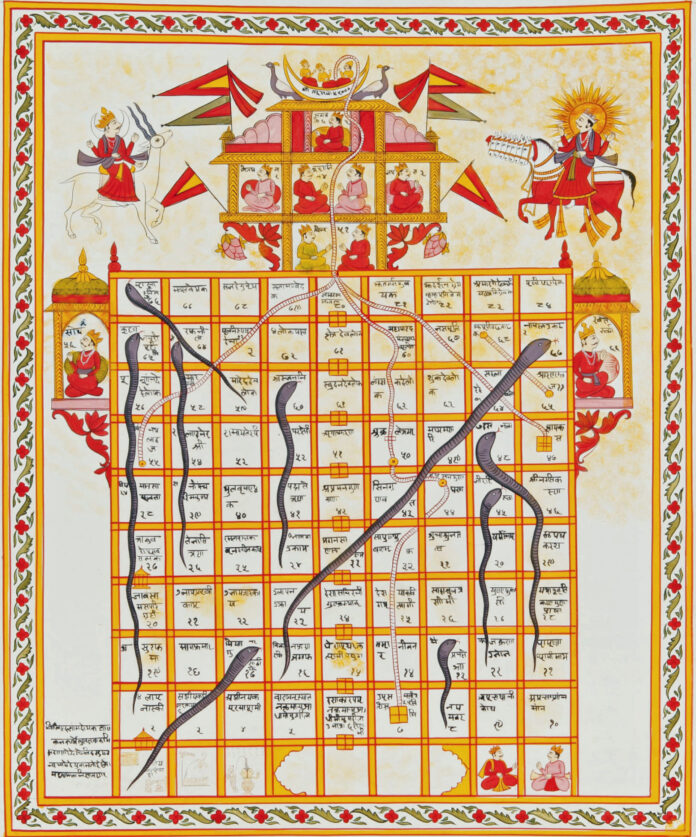Snakes and Ladders is a board game with ancient origins, revered today as a timeless classic enjoyed worldwide. This game, with its rich history and deep philosophical roots, has transcended generations and cultures, evolving while maintaining its core essence.
Origins and Cultural Significance
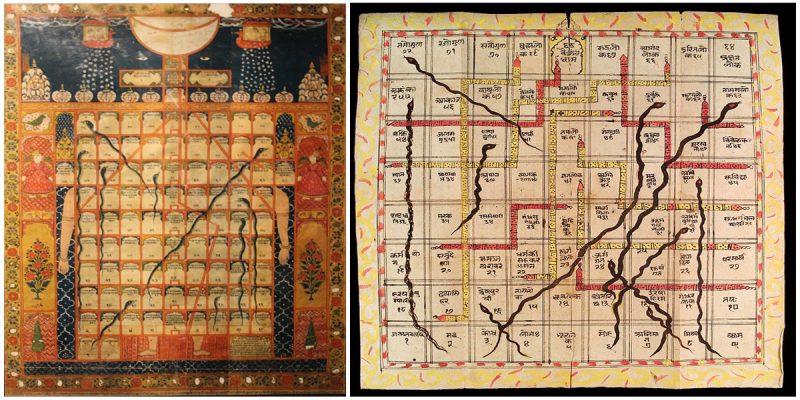
Originating in India, Snakes and Ladders is part of a family of dice board games, which includes the well-known pachisi. This ancient game was historically known by several names, including Moksha Patam, Vaikunthapaali, and Paramapada Sopaanam. Each of these names reflects the game’s spiritual and philosophical roots in traditional Hindu thought. Moksha Patam, for example, translates to “Path to Liberation,” highlighting the game’s focus on the journey towards spiritual enlightenment.
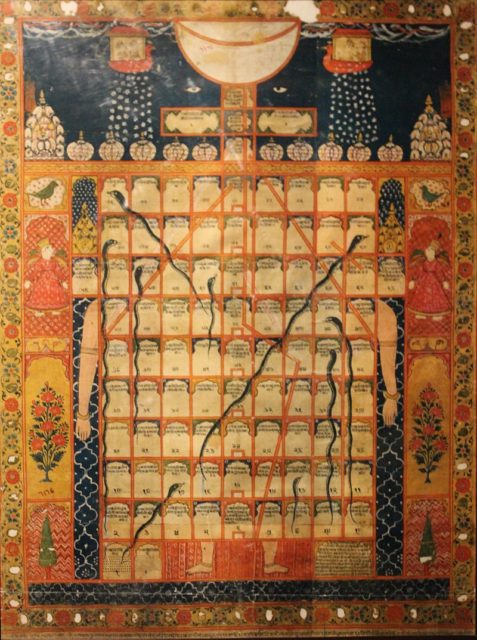
Vaikunthapaali and Paramapada Sopaanam similarly emphasize the ascent to higher spiritual planes. For centuries, Snakes and Ladders has been more than just a pastime; it has been a tool for illustrating the moral lessons of Hindu philosophy, particularly the contrast between karma (action) and kama (desire). The game’s structure, with ladders representing virtues and snakes symbolizing vices, served as a visual and interactive representation of the consequences of good and bad deeds.
Game Structure and Mechanics
Snakes and Ladders is designed for two or more players, making it an engaging and social game. The game board is typically a square grid, divided into numbered squares, usually ranging from 1 to 100. Interspersed among these squares are various ladders and snakes, each connecting two specific squares.
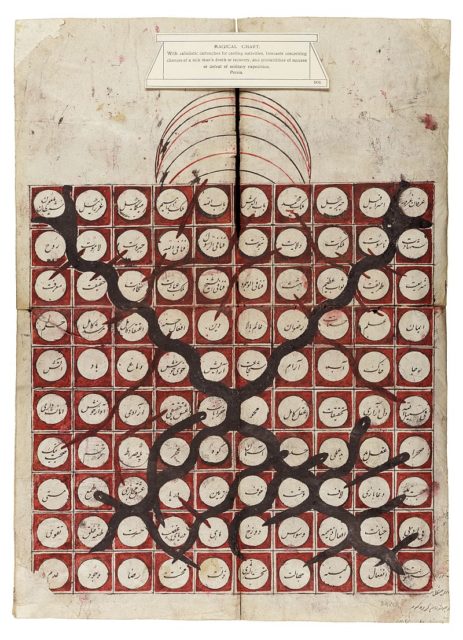
Players begin at the starting square and take turns rolling a single die to determine how many squares to move their game piece. The objective is to be the first to reach the final square, typically numbered 100. As players progress, landing on a square with the base of a ladder allows them to climb up to a higher square, effectively advancing their position. Conversely, landing on a square with the head of a snake results in sliding down to a lower square, setting back their progress.
This dynamic creates an unpredictable and exciting gameplay experience, where fortunes can quickly change. The ladders symbolize positive actions or virtues that propel players forward, while the snakes represent negative actions or vices that cause setbacks. Through its simple yet profound mechanics, Snakes and Ladders metaphorically illustrates life’s journey, highlighting how virtuous deeds lead to progress and misdeeds result in setbacks, thus rewarding good behavior and punishing bad.
Victorian Adaptation
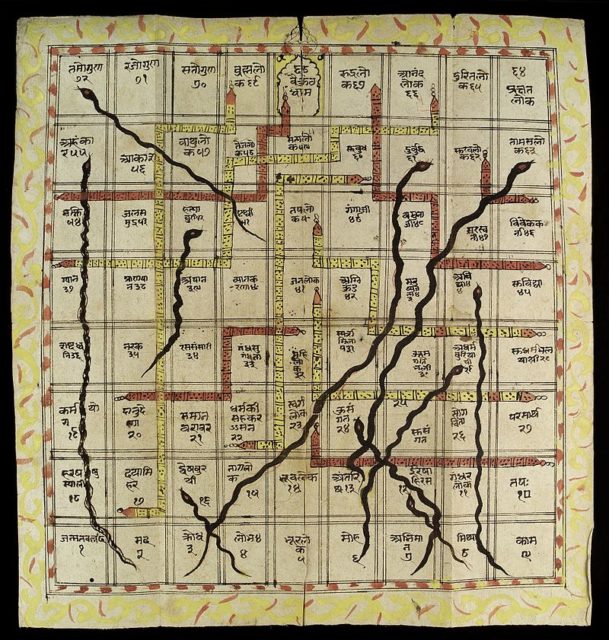
The moral lessons embedded in Snakes and Ladders resonated strongly with the Victorian era’s emphasis on morality and virtue. In 1892, the game was adopted and published in England, bringing it into the homes of Victorian families. While the core gameplay of navigating a game piece from start to finish using dice rolls remained unchanged, the Victorians made modifications to better reflect their societal values.
In the Victorian version, the game board was adorned with rich symbolic imagery. The uppermost sections of the board often depicted gods, angels, and other majestic beings, representing the ultimate moral and spiritual aspirations. The rest of the board was populated with detailed illustrations of animals, flowers, and various human figures, creating a visually engaging and meaningful experience.
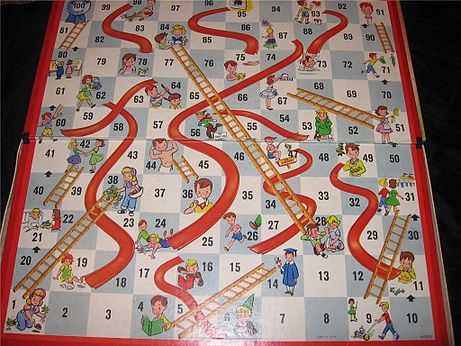
Ladders in the Victorian edition symbolized virtues that were highly regarded at the time, such as generosity, faith, and humility. These virtues helped players advance more rapidly towards the game’s goal, embodying the idea that good deeds and moral behavior lead to success and spiritual elevation. Conversely, the snakes represented vices such as lust, anger, murder, and theft. Landing on these squares would cause a player to slide back, illustrating the setbacks and downfalls associated with immoral actions.
Symbolism in Popular Culture
Snakes and Ladders has significantly influenced popular culture, finding its way into various forms of literature and media. One of the most notable examples is its central metaphorical role in Salman Rushdie’s acclaimed novel, “Midnight’s Children.” In this literary masterpiece, Rushdie draws inspiration from the philosophical underpinnings of the game to convey profound themes about the human experience.

In “Midnight’s Children,” the game of Snakes and Ladders is used to symbolize the unpredictable nature of life. Rushdie masterfully encapsulates the eternal truth that life is a series of ups and downs, much like the game itself. For every ladder that one climbs, representing success, progress, or a stroke of good fortune, there is always a snake lying in wait, ready to bring about a setback or challenge. Conversely, for every snake encountered, symbolizing failure, adversity, or a misfortune, there is a ladder that offers a way out, a new opportunity, or a path to recovery and hope.
This duality of hope and despair, progress and regression, is a central theme in Rushdie’s narrative, reflecting the complex and often tumultuous journey of his characters. The metaphor of Snakes and Ladders thus becomes a poignant tool for exploring the interplay of fate, free will, and the cyclical nature of life’s trials and triumphs.
Rushdie’s use of Snakes and Ladders in “Midnight’s Children” not only highlights the game’s deep philosophical roots but also cements its place in modern storytelling. By incorporating this ancient game into his novel, Rushdie bridges the gap between cultural heritage and contemporary literature, demonstrating the timeless relevance of Snakes and Ladders as a metaphor for the human condition.
Conclusion
Snakes and Ladders is more than just a game; it is a cultural artifact that teaches the interplay of virtues and vices, success and setbacks. Its enduring appeal lies in its simplicity and profound symbolism, making it a cherished pastime for people of all ages across the globe.
